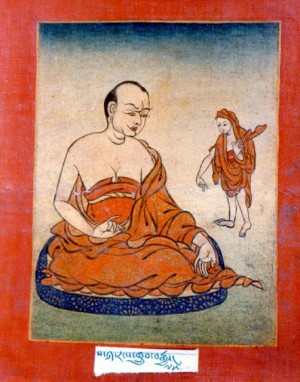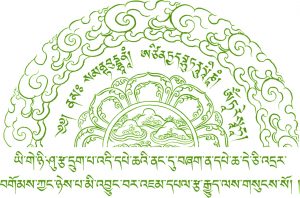Indrabhuti was the great king of Kanci. However, he did not have a son, so he prayed to both the worldly and the transmundane deities for a son to be born to him. One day, a being took residence in his wife’s womb and thoughts of joy arose in her. She had many miraculous signs and when asked the scholars and Brahmans, they said it was the sign that a Bodhisattva will be born.
Nine months later, in the waxing forthnight, a child was born in the center of a lotues, on a great lake. There fell a rain of desirable things in the area. Everyone was amazed, and then realized that it was the power of the child. After this son was born, there came two other sons. When the mother and father died, the people gave the kingdom to the eldest, but he gave it to the younger sons and became a monk.
He then went to Sridhana. On the way, Avalokitesvara appeared to him in the form of a monk, so the prince did not recognize him. The monk then asked if he would like to meet with the Sambhogakaya. At that, the prince did reverence and asked for instructions. Avalokitesvara then manifested his true form and initiated the prince, and then gave him instructions.
When he reached Sridhana, he met a man desiring to be a yogin. The man wished to serve the prince, but he requested to be given instructions once the prince attained siddhi. The prince agreed, then went to a cave and practiced for 12 years.
During this time, a great famine struck the land, and many people died. Afraid he would disturb his guru, the servant lived on the leftovers of the guru’s food. One day, when there was no food left to be found, he went to the palace where he managed to get a bowl of rice gruel. Being weak from no food, he fell in front of the cave and spilled some of the rice. At last, the servant was forced to tell his guru about the famine. The guru then said he have a method of alleviating hunger.
He collected a large amount of rice and made a torma beside a river. He stirred up the eight great nagas by meditating on their symbols and mantras, then brought these nagas overhead by the power of his thoughts. The guru then instructed the nagas to rain down food on the first day. On the second day, grain. On the third day, rain down jewels, and then finally, rain down water. The nagas did what he had instructed and people were free from their sufferings. The people took faith in him.
Saroruha then initiated his former servant, whose name was Rama, and gave him instructions whereby he obtained the worldly powers of siddhi. The guru then instructed his disciple to work for the benefit of living beings and to go to Sriparvata. The guru then went to the realm of the Dakas. Rama brought the daughter of a king to the neighborhood of Sriparvata with his power. They both built temples and finally went to the realm of the Dakas themselves.
em
Busque no site
Busca por Assunto
Artigos Recentes

Sílaba Hung
HUNG é uma expressão de magnetismo e um meio hábil para …Leia Mais »
Phakchok Rinpoche
Kyabgön Phakchok Rinpoche, é o filho de Tsikey Chokling Rinpoche …Leia Mais »Lama Padma Dorje
Lama Padma Dorje (Jeffrey Miller) tornou-se aluno próximo de S. …Leia Mais »
Tendrel
Tendrel – རྟེན་འབྲེལ། rten ‘brel, Pron.: tendrel A palavra tibetana tendrel …Leia Mais »
Saga Dawa
O Saga Dawa é um dos quatro períodos mais sagrados …Leia Mais »



 Cintamani - Meditação e Arte - Copyright 2020 - Todos os direitos reservados.
Cintamani - Meditação e Arte - Copyright 2020 - Todos os direitos reservados.